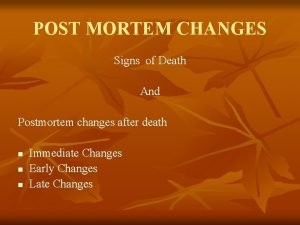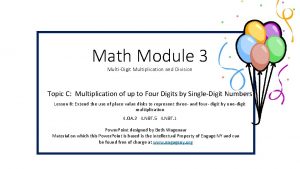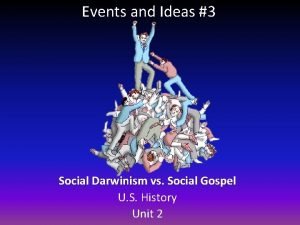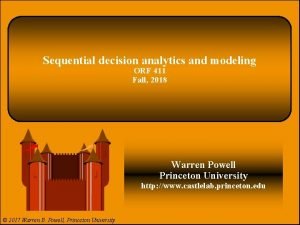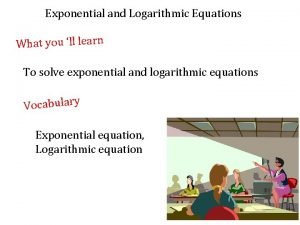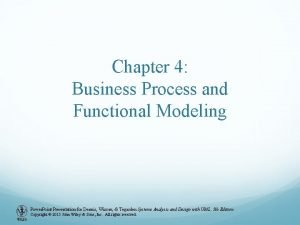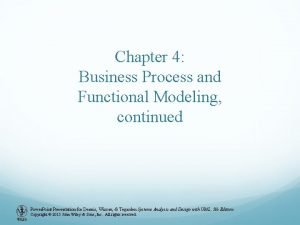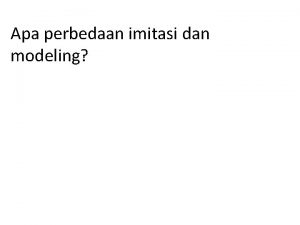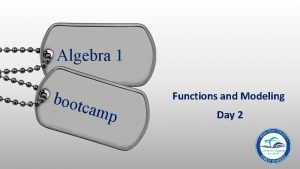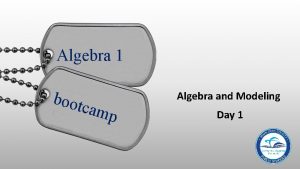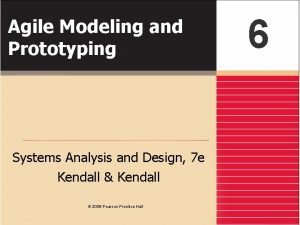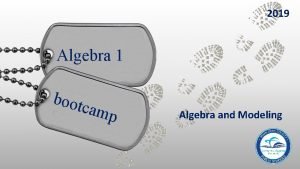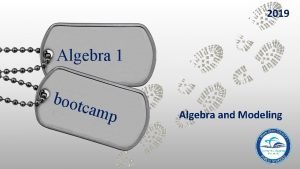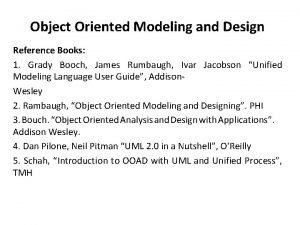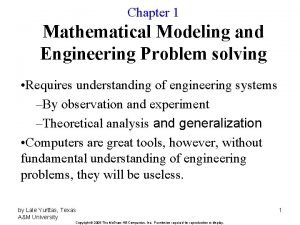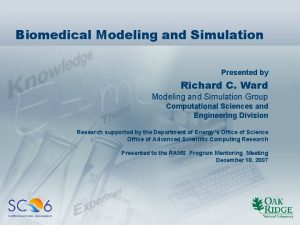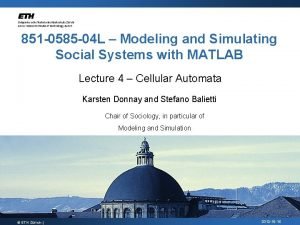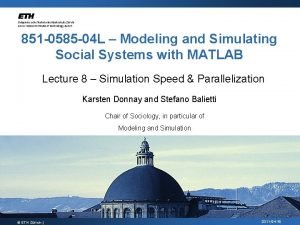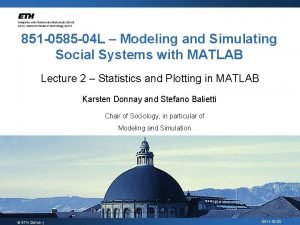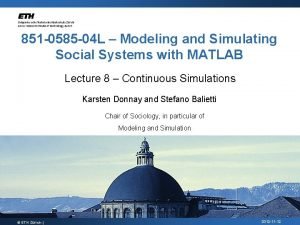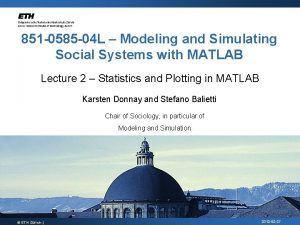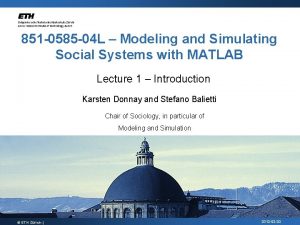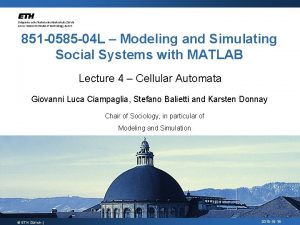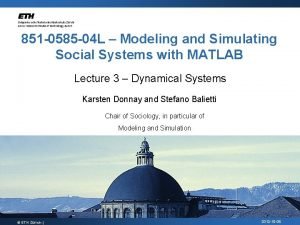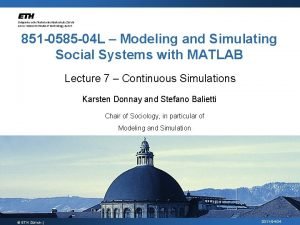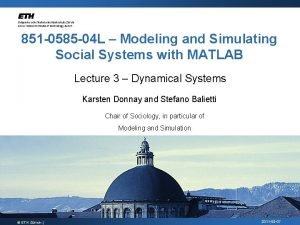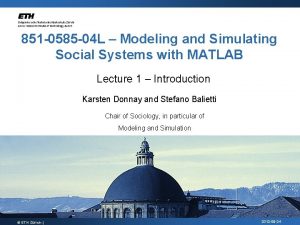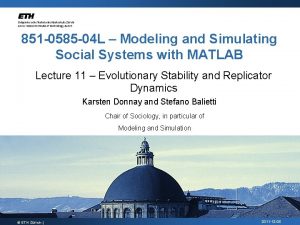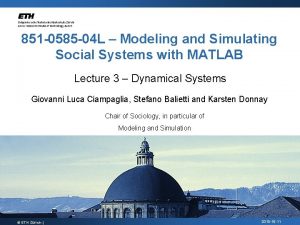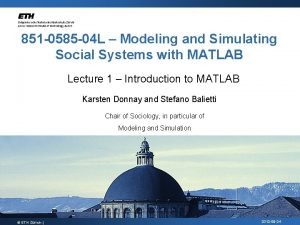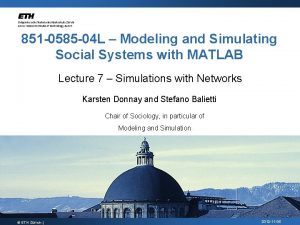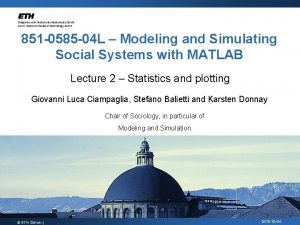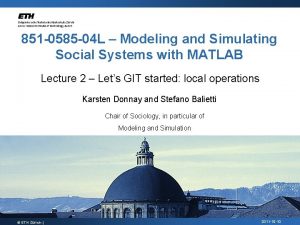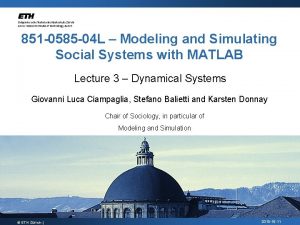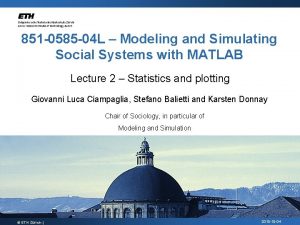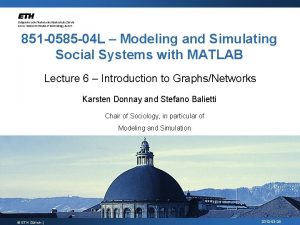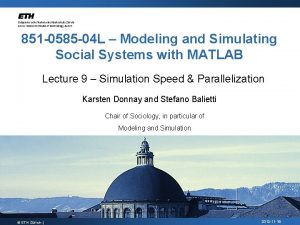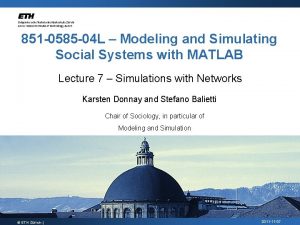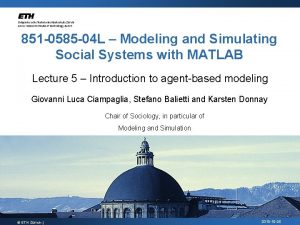851 0585 04 L Modeling and Simulating Social






































- Slides: 38

851 -0585 -04 L – Modeling and Simulating Social Systems with MATLAB Lecture 9 – Scientific Writing and Presentation of Results Karsten Donnay and Stefano Balietti Chair of Sociology, in particular of Modeling and Simulation © ETH Zürich | 2011 -05 -02

Schedule of the course Introduction to MATLAB 21. 02. 28. 02. 07. 03. 14. 03. 21. 03. 28. 03. Working on projects (seminar theses) 04. 18. 04. Introduction to social-science modeling and simulation 02. 05. 09. 05. 16. 05. 23. 05. 30. 05. 2011 -05 -02 Handing in seminar thesis and giving a presentation K. Donnay & S. Balietti / kdonnay@ethz. ch sbalietti@ethz. ch 2

Final presentation schedule § Project presentation 15’ + 5’ (for Q&A) § 3 days available: Thu May 26 th 10 a. m. – 1 p. m. (9 slots) § Mon May 30 th 5 – 7 p. m. (6 slots) § Wed Jun 1 st 4 p. m. – 7 p. m. (9 slots) § § Registration for final presentation is binding; if you do not want to obtain credits, do not register! § Sign up for slot this and next week in class or per email to sbalietti@ethz. ch and kdonnay@ethz. ch 2011 -05 -02 K. Donnay & S. Balietti / kdonnay@ethz. ch sbalietti@ethz. ch 3

Final presentation schedule § due date of reports: midnight of 2 days before your slot § submission deadlines then are: § Tue May 24 th at midnight (if presenting on Thu May 26 th) § Sat May 28 th at midnight (if presenting on May 30 th) § Mon May 30 th at midnight (if presenting on Wed Jun 1 st) § Submission of report & program code by email to sbalietti@ethz. ch and kdonnay@ethz. ch § 2011 -05 -02 remember to put [MATLAB] in the subject line! K. Donnay & S. Balietti / kdonnay@ethz. ch sbalietti@ethz. ch 4

Goals of Lecture 9: students will 1. Refresh knowledge on optimization in MATLAB acquired in lecture 8, through a brief repetition of important points. 2. Receive a quick introduction to scientific writing* and practical advice on the framing of the final report. 3. Get some specific instructions on the expected format of the final report and a content “checklist” to follow when writing up the report. 4. See an example of the level of sophistication we expect in visualizing your model results. * thanks to Heiko Rauhut and Volker Grimm for providing content 2011 -05 -02 K. Donnay & S. Balietti / kdonnay@ethz. ch sbalietti@ethz. ch 5

Repetition § the structure and simplicity of your code is the most important factor for the performance of your program § make use of the MATLAB specific techniques to improve performance when writing routines; use functions over scripts and compartmentalize § test your program for performance, in particular the parts of your code that carry the main computational load; MATLAB’s profiler is very useful for that! § example of vectorizing: can be faster than looping but not necessarily; the only way to know is to test your program under the expected load of the simulation. § parallelization very easy and useful for parameter sweeps 2011 -05 -02 K. Donnay & S. Balietti / kdonnay@ethz. ch sbalietti@ethz. ch 6

Scientific Writing § Clear, easy to read, concise, and precise. avoid metaphors; use examples instead § keep sentences short § § Main purpose: communicate your work so that others can replicate it, modify it and object to it. § It is still a form of creative writing! create a narrative § guide the reader through your project and results § 2011 -05 -02 K. Donnay & S. Balietti / kdonnay@ethz. ch sbalietti@ethz. ch 7

The Hour Glass Structure 2011 -05 -02 K. Donnay & S. Balietti / kdonnay@ethz. ch sbalietti@ethz. ch 8

What are your research questions? § In the introduction of your reports, clearly specify the research questions, e. g. : How does crime influence population growth? § Will the outcome change if mechanism A is changed to mechanism B in the model? How? § Are the results of the model reproducible if the complicated function f(x)=exp(x+y)+y 2 is replaced by the simpler g(x)=x+y ? § § In the “Results” section come back to your research questions. 2011 -05 -02 K. Donnay & S. Balietti / kdonnay@ethz. ch sbalietti@ethz. ch 9

Interpretation of Results § Remember: Correlation does not imply causation § Do not over-interpret your results § Propose an underlying mechanism xkcd. com/552 2011 -05 -02 K. Donnay & S. Balietti / kdonnay@ethz. ch sbalietti@ethz. ch 10

Correlation vs. Causality § Correlation: corrcoef(A, B) = 1. 0000 0. 8390 1. 0000 § Causality: A correlates with B, but how does the causality look like? A 2011 -05 -02 A B C A B A K. Donnay & S. Balietti / kdonnay@ethz. ch sbalietti@ethz. ch B B 11

Reproducibility of Results § It is an important criterion for the quality of scientific work that your results are fully reproducible § Make sure to set and store the random seed of every simulation run to ensure reproducibility § STREAM = Rand. Stream. get. Default. Stream returns default random number stream with its seed value § Rand. Stream. set. Default. Stream(Rand. Stream('mt 19 937 ar', 'seed', Seed. Value) sets the random seed with the (new) value Seed. Value 2011 -05 -02 K. Donnay & S. Balietti / kdonnay@ethz. ch sbalietti@ethz. ch 12

Data Dump – storing your results § Make sure that the results of your simulations are stored at the end of a simulation run § You can for example simply save the results in form of the array structure (matrix, cell array) of your simulation using MATLAB’s save() command § Or you may export them to comma separated files using csvwrite() (and csvread() to recover data) § Documentation on csvwrite() may be found here 2011 -05 -02 K. Donnay & S. Balietti / kdonnay@ethz. ch sbalietti@ethz. ch 13

Visualization of Results § Graphical formats: use PDF or EPS in the print version. JPG (better PNG) just for quick visualizations § Increase the font sizes for readability: set(gca, ‘Font. Size’, 16); § ALWAYS use labels on axes: xlabel(‘Time (s)’, ‘Font. Size’, 16); ylabel(‘Number of Agents’, ‘Font. Size’, 16); 2011 -05 -02 K. Donnay & S. Balietti / kdonnay@ethz. ch sbalietti@ethz. ch 14

Visualization of Results (2) § Put a box around the figure: box on § Show grid: grid on § Use thicker lines: plot(x, y, ‘Line. Width’, 2); § Set axis limits: xlim(x 0, x 0); ylim(y 0, y 0); 2011 -05 -02 K. Donnay & S. Balietti / kdonnay@ethz. ch sbalietti@ethz. ch 15

Example § As an example: Let us say that we have a project about simulating happiness of agents. § We have the result of 10 different simulation runs in y, and the corresponding time vector in x. § x = t 0: dt: t 1; y = [happiness values from simulation 1; happiness values from simulation 2; . . . happiness values from simulation 10]; 2011 -05 -02 K. Donnay & S. Balietti / kdonnay@ethz. ch sbalietti@ethz. ch 16

plot(x, y(1, : )) 2011 -05 -02 K. Donnay & S. Balietti / kdonnay@ethz. ch sbalietti@ethz. ch 17

plot(x, y(1, : )) xlabel(‘Time(days)’) ylabel(‘Fraction of happy agents’) 2011 -05 -02 K. Donnay & S. Balietti / kdonnay@ethz. ch sbalietti@ethz. ch 18

plot(x, y) xlabel(‘Time(days)’) ylabel(‘Fraction of happy agents’) 2011 -05 -02 K. Donnay & S. Balietti / kdonnay@ethz. ch sbalietti@ethz. ch 19

plot(x, y) set(gca, ’Font. Size’, 16) xlabel(‘Time(days)’) ylabel(‘Fraction of happy agents’) 2011 -05 -02 K. Donnay & S. Balietti / kdonnay@ethz. ch sbalietti@ethz. ch 20

errorbar(x, mean(y), std(y)) set(gca, ’Font. Size’, 16) xlabel(‘Time(days)’) ylabel(‘Fraction of happy agents’) 2011 -05 -02 K. Donnay & S. Balietti / kdonnay@ethz. ch sbalietti@ethz. ch 21

errorbar(x, mean(y), std(y), ’k’, ’Line. Width’, 2) set(gca, ’Font. Size’, 16) xlabel(‘Time(days)’) ylabel(‘Fraction of happy agents’) xlim([0 10]) ylim([0. 5]) 2011 -05 -02 K. Donnay & S. Balietti / kdonnay@ethz. ch sbalietti@ethz. ch 22

errorbar(x, mean(y), std(y), ’k’, ’Line. Width’, 2) set(gca, ’Font. Size’, 16) xlabel(‘Time(days)’) ylabel(‘Fraction of happy agents’) xlim([0 10]) ylim([0. 5]) add caption in La. Te. X! 2011 -05 -02 K. Donnay & S. Balietti / kdonnay@ethz. ch sbalietti@ethz. ch 23

errorbar(x, mean(y), std(y), ’k’, ’Line. Width’, 2) set(gca, ’Font. Size’, 16) xlabel(‘Time(days)’) ylabel(‘Fraction of happy agents’) xlim([0 10]) ylim([0. 5]) 2011 -05 -02 K. Donnay & S. Balietti / kdonnay@ethz. ch sbalietti@ethz. ch 24

Important Graphs § semi-logarithmic plot (semilogx() or semilogy()) α = -0. 001 y = exp(α x) α sets the slope of the curve 2011 -05 -02 K. Donnay & S. Balietti / kdonnay@ethz. ch sbalietti@ethz. ch 25

Important Graphs § power law plot (loglog()) α = -1. 2 y = xα α sets the slope of the curve 2011 -05 -02 K. Donnay & S. Balietti / kdonnay@ethz. ch sbalietti@ethz. ch 26

Important Graphs § power law plot with exponential cutoff (loglog()) α = -1. 2 y = xα exp(β x) α sets the slope of the curve β sets the exponential cutoff 2011 -05 -02 K. Donnay & S. Balietti / kdonnay@ethz. ch sbalietti@ethz. ch 27

Phase Diagrams § To show the result depend on two different parameters, phase diagrams can be used: D. Helbing and W. Yu, PNAS (2009) 2011 -05 -02 K. Donnay & S. Balietti / kdonnay@ethz. ch sbalietti@ethz. ch 28

Phase Diagrams § code snippet that uses surf(); here matrix M has as entry (i, j) the model fit for every combination of two parameters (here: a, b) [a, b]=meshgrid(0: 0. 01: 1); hold on; view(0, 90); surf(a, b, M, 'Edge. Color', 'none'); colorbar; set(gca, 'Font. Size', 14) xlabel('parameter a'); ylabel('parameter b'); 2011 -05 -02 K. Donnay & S. Balietti / kdonnay@ethz. ch sbalietti@ethz. ch 29

Phase Diagrams 2011 -05 -02 K. Donnay & S. Balietti / kdonnay@ethz. ch sbalietti@ethz. ch 30

Normalized Parameters § It is usually advantageous to rescale any parameter in your model to a uniform range, for example [0, 1] § Normalized parameters simplify the visualization and analysis of the model results § Ideally, the parameter range of model parameters and their scaling to the uniform range is chosen such that all relevant variations of the model are visible within that range 2011 -05 -02 K. Donnay & S. Balietti / kdonnay@ethz. ch sbalietti@ethz. ch 31

Create Videos § It is helpful to illustrate your simulations with videos during your presentation: 2011 -05 -02 K. Donnay & S. Balietti / kdonnay@ethz. ch sbalietti@ethz. ch 32

Project Report § Have a look at last year’s projects to make sure that you don’t repeat the same results! § Use the report template. § Try to explain your results well, as well as explaining your motivation behind the project. § Include your MATLAB code in the appendix § If you have any problems or concerns with your projects, we are here to help you! 2011 -05 -02 K. Donnay & S. Balietti / kdonnay@ethz. ch sbalietti@ethz. ch 33

Project Report § There a number of things that will certainly negatively affect your grade: § no clearly stated research question § no conclusion regarding the work you have completed and how it relates to your research question § graphs which have no legend, axis labels or caption, are not properly readable or the labels are too small § no references to the literature to validate and back-up your statements/model etc. § submitting you report late or incomplete 2011 -05 -02 K. Donnay & S. Balietti / kdonnay@ethz. ch sbalietti@ethz. ch 34

Project Report § References are very important: § cite the sources you are using § be aware that plagiarism is taken very seriously at ETH, if you are unsure how to cite properly follow ETH’s plagiarism guidelines § we accept both natural science and social science citation conventions but please use them consistently § it is important that your references are correct and correctly formatted! 2011 -05 -02 K. Donnay & S. Balietti / kdonnay@ethz. ch sbalietti@ethz. ch 35

Project Report § Documentation of your code is important § You can, for example, use the following tool to automatically generate html files from comments in your code http: //www. artefact. tk/software/matlab/m 2 html/ § Please also pay attention to the MATLAB code style guidelines provided here to guarantee that your code is flawless and easy to understand 2011 -05 -02 K. Donnay & S. Balietti / kdonnay@ethz. ch sbalietti@ethz. ch 36

Final checklist § A typical scientific report should include: § § § § 2011 -05 -02 Title Abstract Introduction Materials / Methods Results Discussion References Appendix (if needed) Report. Template. zip K. Donnay & S. Balietti / kdonnay@ethz. ch sbalietti@ethz. ch 37

References § MATLAB documentation on plotting § MATLAB code style guidelines § Tool to convert comments to html files § J. -L. Dumont. “Trees, maps and theorems”. Principiae (2009). § Russey, Ebel, Bliefert. “How to Write a Successful Science Thesis”. Wiley (2006). § R. Murray. “How to Write a Thesis”. Open University Press (2006) 2011 -05 -02 K. Donnay & S. Balietti / kdonnay@ethz. ch sbalietti@ethz. ch 38
 Diaphanous test
Diaphanous test Postmortem signs
Postmortem signs Model and role modeling theory
Model and role modeling theory 10 cfr 851
10 cfr 851 Health and safety act ontario
Health and safety act ontario 20 x 3
20 x 3 Relational vs dimensional data modeling
Relational vs dimensional data modeling National general 888-781-0585 nc
National general 888-781-0585 nc Ngic 888-781-0585
Ngic 888-781-0585 Social thinking social influence social relations
Social thinking social influence social relations Social thinking social influence social relations
Social thinking social influence social relations Dfd chapter 5
Dfd chapter 5 Linear quadratic function
Linear quadratic function Dfd chapter 5
Dfd chapter 5 Social darwinism paralleled the economic doctrine of
Social darwinism paralleled the economic doctrine of Simulation modeling and analysis law kelton
Simulation modeling and analysis law kelton Sequential decision analytics
Sequential decision analytics Modeling with exponential and logarithmic equations quiz
Modeling with exponential and logarithmic equations quiz Answers key
Answers key Requirements modeling in system analysis and design
Requirements modeling in system analysis and design Business process and functional modeling
Business process and functional modeling Business process and functional modeling
Business process and functional modeling Unplanned model aba
Unplanned model aba Jelaskan perbedaan imitasi dan
Jelaskan perbedaan imitasi dan Algebra 1 bootcamp functions and modeling answer key
Algebra 1 bootcamp functions and modeling answer key Algebra 1 boot camp
Algebra 1 boot camp Algebra bootcamp answers
Algebra bootcamp answers Patched up prototype
Patched up prototype Additive and subtractive modeling
Additive and subtractive modeling Patched up prototype
Patched up prototype Jackie buys 3 hot dogs and 1 pretzel
Jackie buys 3 hot dogs and 1 pretzel Algebra 1 bootcamp functions and modeling answer key
Algebra 1 bootcamp functions and modeling answer key Object oriented modeling and design books
Object oriented modeling and design books Pharmaceutical simulation and modeling
Pharmaceutical simulation and modeling Introduction to modeling and simulation
Introduction to modeling and simulation Data vault pit table example
Data vault pit table example Mathematical modeling and engineering problem solving
Mathematical modeling and engineering problem solving Biomedical modeling and simulation
Biomedical modeling and simulation Device modeling for analog and rf cmos circuit design
Device modeling for analog and rf cmos circuit design

